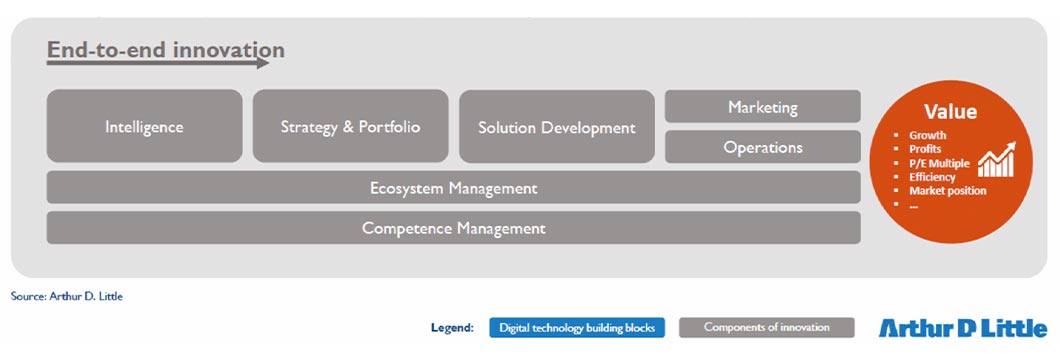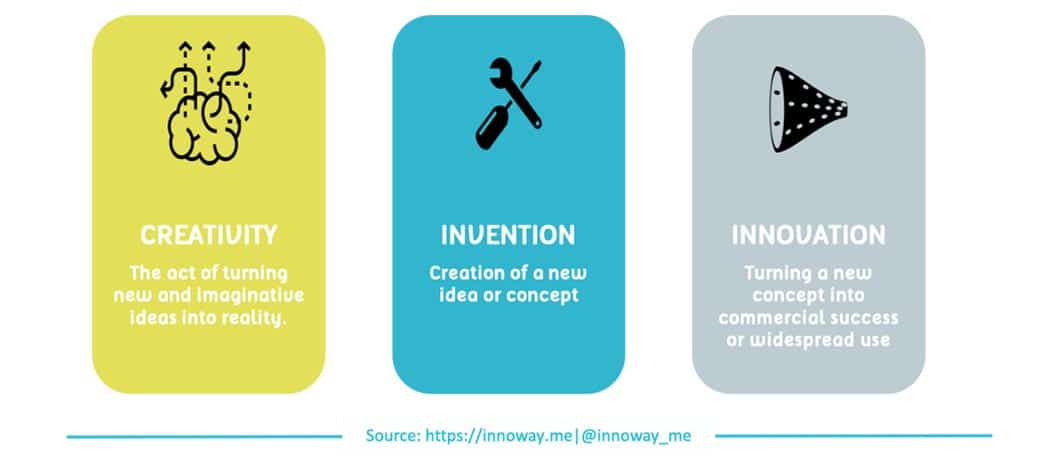Any organization that wants to thrive in today’s fast-changing and competitive business environment can’t afford to ignore innovation. However, new ideas aren’t spaghetti that you throw onto the wall and hope they stick.
Simply inventing something new isn’t enough to keep you competitive. If you fail to introduce the idea to the market and put the product in the hands of the right users, your business won’t benefit from the innovation. Successful initiatives follow proven innovation management principles and are guided by an effective innovation management framework.
Wondering how you can apply an effective innovation management process to your business? Find out what innovation management entails, why it’s important, innovation best practices you should follow, and a few examples to get you inspired.
What Is Innovation Management?
Innovation management provides guidance on inventing something new, such as a product or process, as well as launching the product to the market or introducing the process within the company.
It refers to the handling of all the activities involved in the innovation process, including ideation, prioritization and development of new ideas as well as the introduction of the new product or process to the intended users.
Besides developing new ideas or products, innovation management often involves change management in product development, business processes and organization structure to support the implementation of a new idea.
As the graphic below from Innoway shows, innovation differs from creativity and invention by turning the ideas, concepts and new products into commercial success.
Why Is Innovation Management Important?
Innovation management helps businesses come up with new and creative perspectives to respond to internal and external opportunities in an agile manner. Having a defined structure makes innovation the norm rather than the exception to help you stay relevant and become a leader in your industry. Implementing an innovation management process can help your organization:
- Adopt a customer-centric approach to product and process development so you can stay current with consumer trends and market demand.
- Position your brand as a market leader to attract more customers and stay ahead of the competition.
- Ensure your brand values are upheld in the latest iteration of your products, services and processes as the market evolves.
- Resolve recurring business problems and challenges with creative solutions that may not have been possible in the past.
- Increase productivity and cost-efficiency by introducing new processes that are enabled by new technologies or management approaches.
- Improve staff morale, introduce excitement and encourage progress in the day-to-day operation and production process.
- Attract top-notch talents, which tend to seek out innovative businesses to work for, while improving employee retention and loyalty.
- Empower employees and encourage them to take ownership by giving them the opportunities to contribute ideas and become part of the innovation process.
How to Apply Innovation Management to Your Business
You can apply various innovation management models and processes to guide your efforts. The right approach depends on your organizational structure, the nature of the innovation and the objectives of the initiatives.
Here’s what you should consider when implementing innovation management:
The 4 Major Types of Innovation
You can navigate the innovation process more effectively by implementing a change management strategy suitable for the type of innovation you’re pursuing. While there are many different ways to categorize innovation, here are the 4 main types:
- Incremental innovation: This type of innovation focuses on making improvements to existing tools, processes, technology and markets. You may already be doing that, but applying a structure to the process can help ensure ideas are turned into action while a feedback loop is created to encourage further refinement and innovation.
- Disruptive innovation: This is the bold move that rocks the boat, in a good way. It may even change how consumers interact with the entire product category, as what Apple’s iPhone had accomplished. While this type of innovation can create a huge impact, it’s also riskier and requires a well-orchestrated innovation management process to succeed.
- Architectural innovation: This refers to the use of proven technologies in a new way. By taking something that’s already working and using it in a new way, introducing it to a different market or adapting it for a different user base, you can create value while taking some of the risks out of the equation.
- Radical Innovation: This is the mind-blowing, ground-breaking innovation that often creates an entirely new industry or movement. Yet, for this type of innovation to be successful, you need a radical innovation management approach that can provide a process and structure to turn the idea into reality.
The 4 Key Aspects of Innovation Management
You can approach innovation management by considering how the development and implementation of new processes and ideas are affected by these key aspects:
- Capabilities: These are abilities, insights, know-how and practical skills of the people working for the organization as well as the information capital, tacit knowledge, financial resources, etc., that are required to turn a new idea into reality.
- Structures: An organization’s structure, processes and infrastructure can impact how its capabilities are utilized. These can include communication channels, decision-making chains of command and infrastructure that support the rapid implementation of ideas.
- Culture: A pro-innovation culture can help you attract the right talents to drive innovation in your organization. Promote a culture that values speed, learning and experiment while giving employees the freedom to think out of the box.
- Strategy: Innovative ideas alone aren’t enough to drive success if they aren’t aligned with your organization’s long-term objectives. The right strategy allows you to pursue the most relevant innovative ideas so you can deploy your resources most effectively.
This diagram from Finnish software company Viima shows how effective innovation management brings together capabilities, structures, culture and strategy to bring new ideas into the market.

The 4 Stages of Innovation Management
Understanding and managing the 4 key stages in the innovation lifecycle can help you systematically nurture new ideas and turn them into reality.
- Ideation: Encourage employees to come up with new ideas by giving them time and space to do so. Implement a process to identify ideas that are most relevant to internal challenges or external conditions while being in alignment with your brand values and long-term business goals. Then, focus your resources on bringing them to fruition.
- Collaboration: Break down silos between business units, gather feedback and share knowledge throughout the innovation process to make sure that ideas keep evolving. It also is important to keep all the stakeholders in the loop by communicating the key measures and values associated with the innovation from the outset.
- Value creation: How will innovation create value for your target audience or intended users? To make an innovation a reality, you need to define and communicate how value will be delivered, experienced and acquired. Getting clear on your value proposition can help guide effective execution.
- Implementation: Of course, new ideas won’t do your organization much good if it isn’t turned into reality. If you’re launching a new product, you need to consider manufacturing, procurement, marketing, sales and customer support so you can ensure the initial idea is achieving the intended objective.
How to Design and Implement an Innovation Management Framework
There are myriad considerations in innovation management and following a well-defined framework can help ensure that you have all the key aspects addressed.
What Is an Innovation Management Framework?
An innovation framework helps you harness employee creativity and turn it into reality while staying in alignment with the overall corporate strategy and business goals. It should be designed to improve your corporate culture, increase employee engagement in the innovation process and generate a consistent stream of ideas with tangible business impacts.
This diagram from management consulting company Arthur D Little shows how an innovation process could look like from end to end and the many components required for success.

Key Steps in Creating an Innovation Management Framework
An innovation management framework facilitates innovation among employees at all levels and across the entire organization.
Here are the key steps to follow when designing such a system:
- Create a global and scalable platform that can facilitate idea exchange and collaboration among employees.
- Select a community of innovation champions to promote idea exchange for large challenges that have a significant impact on the business.
- Engage your employees by having the innovation champions consistently promote, evangelize, coach and encourage teams to innovate.
- Implement an idea management tool that makes it easy for employees to participate in the ideation exercise while bringing transparency to the innovation process.
- Focus on ideation activities targeted to solve specific business needs because the concepts are more likely to be adopted and come to fruition.
- Implement a rigorous triage process to review ideas. This can reduce risks while ensuring incremental funding and recognition to keep the process moving forward.
Best Practices for Innovation Management
While each company needs to establish its own approach to innovation management based on its needs and business objectives, here are some guidelines for implementing innovation in organizations that can help increase the likelihood of success:
- Continuous improvements: Cultivate a growth mindset across the organization that encourages everyone to do something better every day.
- Value creation: Focus on serving your market and customers by delivering as much value as possible through your innovations.
- Build-measure-learn feedback loop: Increase the velocity of innovation by adopting an agile process that allows you to experiment and learn quickly.
- Resource allocation: Providing the right resources helps ensure that an idea is turned into reality while showing employees that the company takes their efforts seriously.
- Company culture: The right mix of talents and team culture is the winning formula for fostering innovation in today’s complex business environment.
- Focus: Direct your efforts and resources to where new ideas can make the biggest impact so you can avoid getting caught in the bright shiny object syndrome.
- The right KPIs: Select the appropriate metrics to measure input and output so you can track progress and optimize your return on investment (ROI).
Innovation Management Examples
Now you may be wondering, innovation management sounds good but how does it work in real-world situations? Here are some successful innovation management examples:
Toyota Harnesses Employee Intellect
Japanese car maker Toyota gives every employee the skills, tools and permission to solve problems as they arise. Many of these incremental innovation ideas have helped the company stay ahead of its competition in the marketplace.
Since the innovative perspectives come from the trenches, they solve many challenges that upper management may not see until they fester into larger issues. By nipping these problems in the bud, Toyota leverages the intellect of every employee to move the business forward.
Whole Foods Builds a Community That Creates Value
John Mackey, founder and CEO of Whole Foods, describes the company as a “community working together to create value for other people.” The focus on value creation, which is a key driver in innovation management, allows the company to nurture ideas that align with its business objectives.
The company has a management system that empowers team members to make store-level decisions and each team to decide on what to stock. Teams can implement innovative ideas and processes based on their specific circumstances to improve the customer experience.
Google Makes Innovation Every Employee’s Job
Google encourages employees to work on innovative ideas that will benefit the organization. Employees who have an idea that isn’t related to their jobs can spend 5%-10% of their time at work to explore the innovation until they can demonstrate the impact of the idea.
As a result, Google generated some game-changing applications that might not have been possible within a top-down management system. Tools such as Gmail, Google Talk and AdSense not only help the company increase profit but position it as an unparalleled leader in the industry.
Unlock Future Success With Innovation Management
When you’re focusing on the day-to-day operation of your company, innovation management may not be at the top of your mind. However, to ensure the long-term success of your business, you need to fuel the development of new ideas, products and processes.
By understanding the key innovation management principles and implementing an innovation management framework, you can ensure that employees have the channels and resources to share their ideas and collaborate. This will help you pursue innovations that are aligned with the company’s values and keep the brand relevant for years to come.












